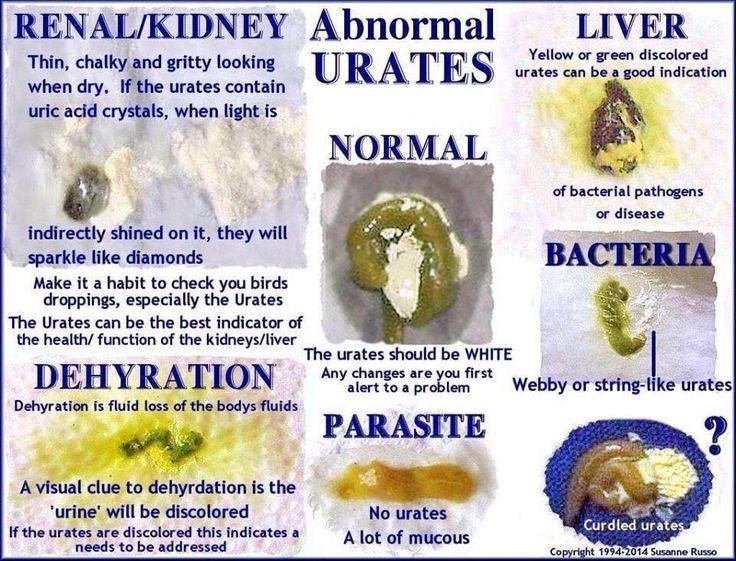Goodness knows this is something that, if you're a bird owner, you deal with on a regular basis. We all spend a lot of time and energy on what goes INTO our birds but lets take a quick moment to consider the "end product" of that process.
Learning to "read" your bird's output is a smart thing to do because this is where you are getting first-hand communication on your bird's health. As they say "Poop is the window to the soul" ... no, wait ... that isn't right is it? Poop is the window to the internal workings of your bird though, so here is a image that will help you discern when you need to pack up the carrier and make a trip to the Vet.
Be aware that what they eat will impact the appearance and consistency of their droppings. Make it a point to check and know what is normal for your bird. For example:
Grapes are very high in water content so be prepared for a lot of clear liquid ... I mean a LOT!!
Beats or Pomegranate? ... crime scene.
New to the pellets? ... um, baby poop brown.
ZuPreem pellets (yes, the food coloring is perfectly safe) ... a kaleidoscope.
Morning poop? ... get the shovel out (as in a large deposit at the "local branch" if you know what I mean).
There are three parts to a bird's droppings: the solid matter (feces), the liquid portion (urine), and the white creamy portion (urates).
Feces
Feces is the waste matter left over from the digestion process. All the nutrients that the bird can extract have been removed and the feces is the solid matter that is left over. Check this part for color and form. Feces should be solid and formed. It may be broken up some in the liquid portion but should still have some form to it. The color of the feces portion will vary depending on the diet but this does not apply to urine.
Red foods (like beets) will produce red droppings;
green veggies will produce green;
pellets and orange veggies will produce brown (unless your feeding colored pellets then all bets are off); and
berries (blue berries and black berries) can produce black droppings.
A sudden change in the color of feces that cannot be attributed to food should be taken very seriously.
Black or tar-like feces indicates internal bleeding (usually high in the GI tract)
Undigested foods can be a sign of PDD (Proventricular Dilation Disease)
Very light colored (clay or pea green) can be liver, pancreas, or digestive problems
Diarrhea is when fecal matter is not holding a shape but is loose like pudding. If you notice black droppings and the color cannot be expained by the food intake then get your pet to the vet immediately. This is serious and can result in death if not treated in a timely manner.
Urine
Urine is the body's way of eliminating excess water, salts, nitrogen compounds, and other waste products from the blood by the kidneys. The non-crystal, clear portion of the dropping is the urine. This is usually thicker than water, kind of a thin syrup consistency, and should be relatively clear. Urates can intermingle with the urine to produce a slight cloudiness but there should be no color.
Green or Yellow color can indicate liver disease
Red indicates bleeding low in the GI tract, possible lead poison, or liver disease
Bubbles can indicate a yeast infection
Increased output can result from eating high water content foods or bacterial infection
Urate
Uricotelism is the ridding of excess nitrogen using uric acid; birds, reptiles, and insects are uricotelic. The product of protein breakdown in the system is excreted as a slurry (urates) by the kidneys; this is the urate or white portion of the droppings. Uric acid is less toxic than ammonia or urea, and it contains four nitrogen atoms and only a small amount of water needed for excretion.
Gout occurs when uric acid crystals deposit in the body's organs (visceral gout), joints (articular gout) or in the ureters (renal constipation). High dietary levels of protein and calcium, hypervitaminosis D3, poor kidney response, dehydration, cold weather and other stress factors work in concert to interfere with the kidney’s ability to adequately excrete uric acid.
Green or Yellow color indicates liver disease or anorexia
Brown indicates lead poisoning
Red indicates fresh internal bleeding or kidney disease
Increased Urates: Dehydration* and possible kidney problems
A web-like appearance can indicate bacterial infection

The first droppings of the day are the best to check. Usually the volume is larger and you can get a good amount of all three parts to analyze. Take a photo and mark that time and date and put it in your health binder.
Your first action if something "seems off" should be to assess the diet prior to determine if that could have an impact on what you're seeing. Watch and document the next couple of droppings and see if the "alarm" factor goes away.
Keeping a watchful eye on your bird's "deposits at the local branch" is a best practice for any bird owner. If there is any evidence of blood call your Vet immediately. If your bird is acting sick along with concerning droppings call your Vet immediately.
Sources:
https://www.beautyofbirds.com/poopology.html
http://avianmedicine.net/publication_cat/avian-medicine/, Patricia Macwhirter, Chapter 31-Malnutrition


